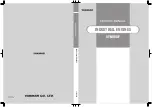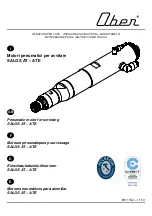
20
CARRIAGE AND STORAGE
EN
GLISH
CARRIAGE AND STORAGE
CARRIAGE
To avoid personal injury:
A
Fix the engine securely not to fall
during operation.
A
Do not stand near or under the
engine while carrying it.
A
The engine is heavy. In handling it,
be very alert not to get your hands
and body caught in.
1. Use carrier such as crane when carrying the engine,
or hurt your waist and yourself. Support the engine
securely with rope not to fall while carrying it.
2. When lifting the engine, put the hook securely to metal
fittings attached to the engine. Use strong hook and
fittings enough to hang the engine.
STORAGE
To avoid personal injury:
A
Do not clean the machine with engine
running.
A
To avoid the danger of exhaust fume
poisoning, do not operate the engine
in a closed building without proper
ventilation.
A
When storing the engine just after
running, let the engine cool off.
Before storing the engine for more than a few months,
remove any dirt on the machine, and:
1. Drain the coolant in the radiator. Open the cock at the
bottom of the radiator, and remove the pressure cap
to drain water completely. Leave the cock open. Hang
a note written "No water" on the pressure cap. Since
water may freeze when the temperature drops below
0 C (32 F), it is very important that no water is left in
the machine.
2. Remove dirty engine oil, fill with new oil and run the
engine for about 5 minutes to let the oil penetrate to all
the parts.
3. Check all the bolts and nuts, and tighten if necessary.
4. Remove the battery from the engine, adjust the
electrolyte level, and recharge it. Store the battery in a
dry and dark place.
5. When the engine is not used for a long period of time,
run it for about 5 minutes under no load every 2 to 3
months to keep it free from rust. If the engine is stored
without any running, moisture in the air may condense
into dew over the sliding parts of the engine, resulting
in rust there.
6. If you forget to run the engine for longer than 5 to 6
months, apply enough engine oil to the valve guide
and valve stem seal and make sure the valve works
smoothly before starting the engine.
7. Store the engine in a flat place and remove the key
from engine.
8. Do not store the engine in a place where has
flammable materials such as dry grass or straw.
9. When covering the engine for storage, let engine and
muffler cool off completely.
10. Operate the engine after checking and repairing
damaged wirings or pipes, and clearing flammable
materials carried by mouse.
E.book 20 ページ 2011年5月31日 火曜日 午後3時45分









































